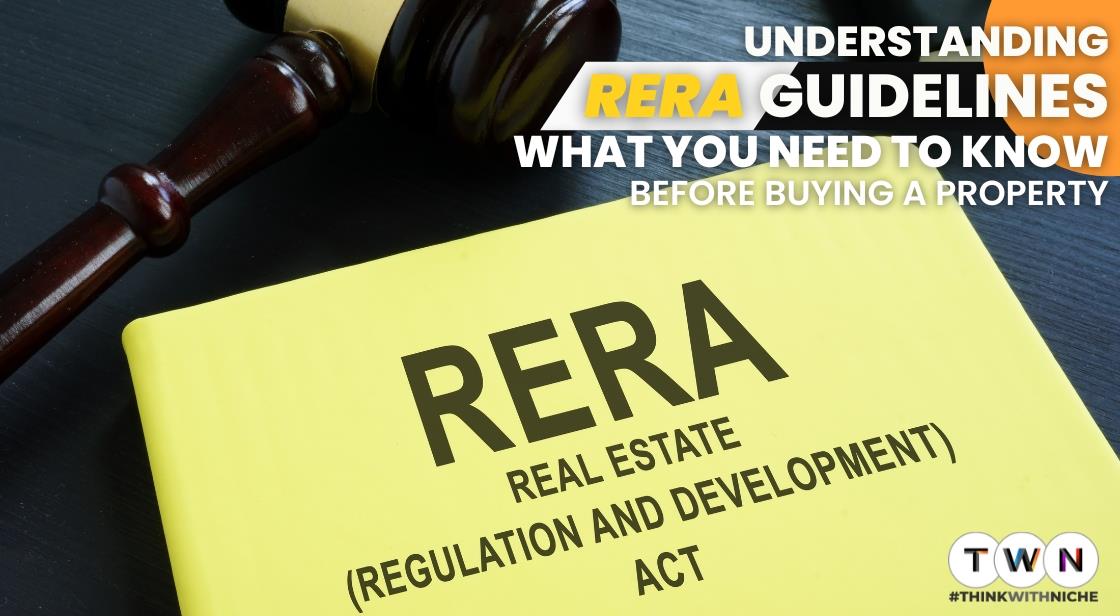Understanding RERA Guidelines: What You Need to Know Before Buying a Property

Blog Post
The Real Estate (Regulation and Development) Act, 2016 (RERA) is a significant piece of legislation that was passed by the Indian parliament to regulate the real estate sector in the country. Its aim is to safeguard the interests of home buyers and investors, while also promoting transparency and accountability in the real estate industry. The bill was passed by the Rajya Sabha on March 10, 2016, and by the Lok Sabha on March 15, 2016, before coming into effect on May 1, 2016. While 59 of its 92 sections were notified on May 1, 2016, the remaining provisions were implemented from May 1, 2017.
The RERA has had a significant impact on the Indian real estate market. The Act has led to a surge in investor confidence in the sector, due to the transparency and accountability that it has brought. It has also improved the credibility of developers, as they are now required to provide more detailed information about their projects to buyers. The Act has also streamlined the process of project approvals, making it easier and faster for developers to obtain clearances.
Under the RERA Act, state governments are required to notify their own rules under the Act, on the basis of the model rules framed under the central Act. This has led to some variation in the implementation of the Act across different states in India.
Currently, the real estate scenario in India is evolving rapidly, with new technologies and innovative business models coming into play. The implementation of RERA has led to greater transparency and accountability in the industry, which has improved investor confidence in the sector. However, the sector still faces challenges such as delays in project approvals, lack of affordable housing, and a shortage of skilled labor. Nevertheless, with the implementation of RERA and the increasing use of technology, the Indian real estate market is poised for growth and development in the coming years.
The COVID-19 pandemic has significantly impacted the Indian real estate sector, leading to a slowdown in construction activities and a decline in demand for properties. However, with the gradual easing of lockdown restrictions and the vaccination drive, the sector is expected to pick up in the coming months. The implementation of RERA has brought transparency and accountability in the sector, boosting buyers' confidence in investing in real estate.
Understanding RERA Guidelines: What You Need to Know Before Buying a Property
RERA Guidelines for Property Developers
Project Registration and Documentation
The Real Estate (Regulation and Development) Act, 2016 (RERA) has set guidelines for property developers to ensure transparency and accountability in the real estate sector. As per RERA guidelines, developers must register their projects with the appropriate regulatory authority and obtain all necessary approvals and clearances before launching the project. They must also maintain accurate and up-to-date documentation, including project timelines, construction schedules, and financial details.
Pricing and Quality Standards
To promote fair practices in the real estate industry, RERA has mandated that developers must follow certain pricing and quality standards. They must disclose the carpet area, which is the area within the four walls of the residential unit, and sell properties based on this measurement. The price of the property should be based on the carpet area and not the super built-up area. Developers must also ensure that the property is built to a high quality and meets all relevant standards.
Escrow Account
RERA has made it mandatory for developers to maintain an escrow account to protect the interests of homebuyers. They must deposit 70% of the money received from customers in this account, and use it only for construction-related expenses. This ensures that the funds are not diverted to other projects and that the construction of the property is completed on time.
RERA Guidelines for Property Buyers
Project Registration and Documentation
Before buying a property, it is important to check whether the project or the building is registered with RERA. This can be done easily by visiting the online portal of the respective state RERA and searching for the project using its unique RERA registration number or name. Buyers must also ask the developer for all necessary documents related to the project, including project timelines, construction schedules, and financial details.
Carpet Area
RERA recognises only the carpet area, which is the area within the four walls of the residential unit. Therefore, buyers should always measure the carpet area before concluding the transaction. The carpet area should be as per what was committed by the developer in the sale agreement.
Structural Defects and Compensation
If any structural defect or defect in workmanship, quality, or provision of services is found within five years of possession, the developer is obligated to rectify it within thirty days without any further charge. If the developer fails to do so, the buyer is entitled to receive appropriate compensation as per the RERA guidelines. However, if the defect is due to negligence or wear and tear, the developer is not liable to repair it. Hence, buyers should thoroughly inspect the property with the help of experts before accepting possession and keep an inspection report as a record.
What is Real Estate (Regulation and Development) Act, 2016 (RERA)
The Real Estate (Regulation and Development) Act, 2016 (RERA) is a landmark legislation passed by the Indian Parliament in March 2016. The Act was enacted to regulate and promote transparency in the real estate sector in India. The Act was implemented in May 2017 and has since then significantly impacted the real estate industry in the country.
Key Provisions of RERA:
- Establishment of State Real Estate Regulatory Authorities (RERAs) in every state to oversee and regulate the real estate sector.
- Compulsory registration of all new and ongoing real estate projects with RERAs.
- Builders are required to disclose all relevant information related to the project, such as land status, approvals, layout plans, timelines, and completion schedule.
- 70% of the funds collected from buyers must be deposited in a separate escrow account to ensure that the funds are used only for construction purposes.
- Builders are required to provide a one-year warranty against any defects in the construction.
- RERAs have the power to impose penalties and fines on builders who violate the Act's provisions.
Impact of RERA:
- Increased Transparency: RERA has brought in much-needed transparency in the real estate sector, making it mandatory for builders to disclose all relevant information related to the project, which has helped buyers make informed decisions.
- Increased Accountability: With RERA in place, builders are now more accountable to buyers, as they are required to complete the project within the promised timeline and quality standards.
- Improved Consumer Confidence: The Act has helped improve consumer confidence in the real estate sector, as buyers now have a reliable legal framework to protect their interests.
- Consolidation of the Real Estate Market: RERA has led to the consolidation of the real estate market, as small and unscrupulous builders have been forced to exit the market due to the stricter regulations.
Carpet Area Defined Under RERA Act
The Real Estate (Regulation and Development) Act, 2016 (RERA) has brought in significant changes in the real estate industry, including mandating the use of carpet area for the sale of apartments. "Carpet area is the total area of the floor that can be used within the walls of the apartment. This does not include areas like open terrace, shafts, balconies, etc." This standardization of the carpet area definition has been introduced to prevent unlawful practices by developers and to ensure that buyers are not misled.
Developers can inflate the saleable area by using a high loading factor, thereby reducing the rate per square feet on the inflated area. This can be misleading for homebuyers who assume that they are getting better rates. However, the size of the flat remains the same, only the loading factor changes. The use of the standard carpet area definition ensures certainty in the usable area and helps in the analysis of cost per square feet. It also facilitates the comparison of different projects.
Also Read: How Technology Can Empower the Indian MSME Landscape
How to Ensure that the Property is RERA Compliant?
To ensure that a property is RERA compliant, certain factors must be considered. If the area of the property is over 500 square meters, the builders should register it under RERA Act before launching or advertising the project. Builders must provide proof that 70% of the total payment has been deposited into a discrete escrow account instead of being used for other investments. Moreover, builders must obtain all the necessary consents before advertising a new project. Discounts for early bird bookings and pre-launch offers are no longer permitted.
RERA compliance is crucial for both developers and buyers as it promotes transparency, accountability, and standardization in the real estate industry. By adopting these practices, the real estate industry can become more trustworthy and credible, which can benefit all stakeholders involved.
RERA Approved Projects: Guidelines and Compliance Requirements
Real Estate (Regulation and Development) Act, 2016 (RERA) is an important legislation aimed at safeguarding the interests of home buyers in India. Under RERA, all real estate projects must be registered with the regulatory authority and comply with the prescribed rules and regulations.
Projects Eligible for RERA Approval:
RERA approval is mandatory for commercial and residential projects, including plotted development, that measure more than 500 square meters or have eight or more units. Additionally, projects without a completion certificate before the commencement of the Act are also required to be RERA compliant.
Projects that are solely for the purpose of renovation, repair, or redevelopment, and do not involve re-allotment and marketing, advertising, selling, or new allotment of any apartments, plot, or building in the real estate project, do not come under RERA. Each phase of a project is treated as a standalone real estate project requiring fresh registration.
Requirements for RERA Approval and Builder Compliance:
-
Project Registration: The builder must register the project with the regulatory authority before advertising or selling any units.
-
Advertisement: All advertising material must contain the RERA registration number and other prescribed details.
-
Withdrawal - POC Method: In case of withdrawal, the builder must refund the amount collected from the allottees with interest through the Project Account linked to the project.
-
Website Updation/Disclosures: The builder must update the project's website regularly and disclose all information as per RERA guidelines.
-
Carpet Area: The builder must sell units based on the carpet area, which is the total area of the floor that can be used within the walls of the apartment.
-
Alteration in Project - Approval of 2/3 Allottees: Any changes to the project plan or layout must be approved by at least two-thirds of the allottees.
-
Project Accounts - Audit: The builder must maintain a separate project account and get it audited by a chartered accountant.
-
70% of Funds Deposited in Project Account: The builder must deposit 70% of the funds collected from allottees in the project account, which can only be used for construction and land cost.
-
Withdrawals Proportional to Percentage Completion: The withdrawals from the project account must be proportional to the percentage of completion of the project, and certified by an engineer, architect, and CA.
-
Provision for RERA to Freeze Project Bank Accounts: RERA has the authority to freeze the project bank accounts upon non-compliance.
-
Interest on Delay Same for Customer and Promoter: The interest on delay in payment or delivery of the unit will be the same for the customer and the promoter.
Latest Facts and Data:
As per the latest data released by the Ministry of Housing and Urban Affairs in March 2021, a total of 67,313 real estate projects have been registered with RERAs since its implementation in May 2017. Out of these, 51,513 projects have been completed, while 15,800 projects are ongoing. The data also revealed that Maharashtra, Uttar Pradesh, and Gujarat have the highest number of registered projects under RERA.
Conclusion
RERA has brought about a significant change in the Indian real estate industry by promoting transparency, accountability, and efficiency. By following the RERA guidelines, developers and buyers can ensure fair practices and win the trust and confidence of each other.Overall, RERA has been a game-changer for the real estate sector in India, bringing in much-needed transparency and accountability in the sector. The Act has helped improve consumer confidence and has led to the consolidation of the real estate market, which is expected to benefit the industry in the long run.
You May Like
EDITOR’S CHOICE












